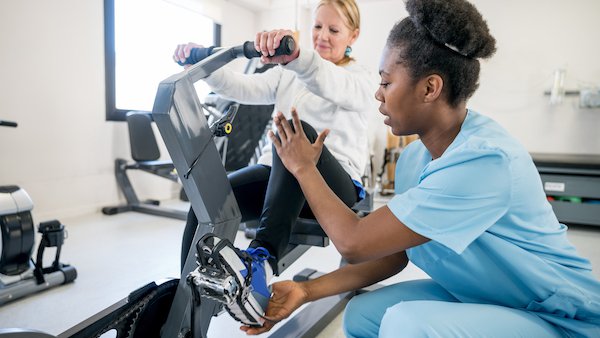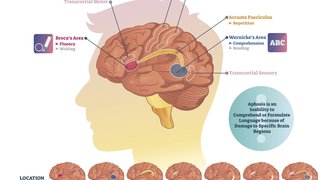
Dizziness, fainting, fatigue, rapid heart rate, brain fog. In the post-pandemic world, these symptoms have become associated with patients suffering from Long COVID – the lasting effects of an infection from the novel coronavirus SARS-CoV-2. But these are the same symptoms that are associated with a common disorder of the autonomic nervous system called postural orthostatic tachycardia syndrome (POTS).
In fact, symptoms cross over so much that POTS may be over-diagnosed in patients after COVID infection while some true POTS diagnoses are being missed.
In a study we presented at the 2023 American Academy of Neurology Annual Meeting, we evaluated 80 patients who had persistent symptoms after COVID infection. Although these patients had symptoms suggestive of POTS, we found that only 12 met the diagnostic criteria for POTS, and five of these 12 had been diagnosed prior to having COVID.
We were surprised there weren’t more since POTS can be triggered by underlying health problems such as viral infections. The rate of POTS in this study population aligned with the highest estimates in previous research, which suggests that 2-14% of patients develop POTS after having COVID.
While POTS isn’t life-threatening, its symptoms can significantly interfere with everyday activities. With POTS, your heart beats faster when you transition from sitting or lying down to standing. Blood returns slowly to the heart and head, causing lightheadedness or fainting that can be relieved by lying down again.
Long COVID emerged over the course of the pandemic as a subset of patients continued to deal with lingering symptoms and lasting effects on their muscle, lung, and brain function. With an accurate diagnosis and support from a team of specialists, most patients can manage POTS symptoms or recover completely. Patients with Long COVID are often referred to UT Southwestern’s COVID Recover program for outpatient rehabilitation.
So, how do you tell if your symptoms are being caused by POTS or another condition, such as Long COVID? Getting the right diagnosis starts with a relatively simple standing test (measuring heart rate and blood pressure while lying down and again after standing for several minutes) or formal tilt-table test.
What is POTS?
POTS is not a disease. It’s a phenomenon that occurs when the autonomic nervous system has an exaggerated response to standing upright. The autonomic nervous system regulates involuntary functions such as heart rate, blood pressure, sweating, and digestion, regardless of whether you’re standing, sitting, or lying down.
When you stand up quickly, particularly after sitting or lying down for a long time, it’s normal for anyone to occasionally feel lightheaded or dizzy. But people with POTS get this sensation often, even when they stand slowly, and symptoms can be debilitating.
It is estimated that more than 1 million people in the U.S. have POTS, most of whom are females aged 15 to 50. The risk is higher in patients with autoimmune conditions such as lupus or after a viral infection (such as mononucleosis or COVID-19), head injury, major surgery, or pregnancy. Most patients with POTS are found to have an overall low fluid volume in the body, even if they are hydrating properly.
Along with lightheadedness or dizziness and fainting or near fainting, POTS also can cause:
- Brain fog – forgetfulness or trouble focusing
- Fatigue
- Feeling nervous or anxious
- Excessive sweating
- Shortness of breath
- Nausea, bloating, or diarrhea
Understanding POTS and the autonomic nervous system
Dr. Steven Vernino's lab at UT Southwestern focuses its research on the autonomic nervous system, which regulates involuntary functions such as heart rate, blood pressure, sweating, and digestion. POTS symptoms are often an exaggerated response to the autonomic nervous system.
How is POTS diagnosed?
A standing test or tilt-table testing is the main method to accurately diagnose POTS. On a tilt-table test, you lie on a special table which has safety straps to prevent falling. The table tilts up until you are standing. Heart rate and blood pressure are recorded throughout the procedure. If you have POTS, the heart rate increases 30 or more beats a minute (40 beats for patients 19 or younger) and may exceed 120 beats per minute within 10 minutes of standing up.
If you’ve been told you have POTS but have not done a tilt-table test or a 10-minute standing test – or if your heart rate didn’t increase a lot when you stood up – you may have been misdiagnosed. Ask your provider to verify a POTS diagnosis if you’ve had symptoms for six months or longer.
Findings from the tilt-table test that do not indicate POTS include:
- Blood pressure drops when standing: This may be a disorder called orthostatic hypotension, which can be treated with lifestyle changes or medication.
- Heart rate and blood pressure stay the same, but you faint or feel lightheaded: We’re seeing this in many patients with Long COVID, and researchers are investigating what could be causing it.
To rule out other conditions, the doctor may also recommend other tests of the heart and autonomic nervous system, such as:
- Blood and urine tests
- Quantitative sudomotor axon reflex test (QSART), which is a measurement of the nerves that control your sweating
- Autonomic heart rate variability test, which looks at how much your heart rate changes in response to breathing
- Echocardiogram, which can help tell how much blood your heart can pump and how well the blood travels through the body
- Ambulatory ECG (Holter monitor)
What are the treatments for POTS?
In many cases, there is no clear single cause for POTS. In cases where a cause is found, treatment of the underlying cause is critical. For example, POTS can be triggered by viral infections, autoimmune diseases, genetic disorders, medications, and made worse by problems such as inflammation, dehydration, and overheating.
Even if no specific cause is identified, there are effective interventions to help reduce the symptoms of POTS. Because the autonomic system interacts with almost every part of the body, we collaborate with colleagues in cardiology, rheumatology, allergy, gastroenterology, and urology to develop a coordinated care plan for every patient.
Some of the standard treatments include:
- Consume more water and salt. Both can help boost your total blood volume.
- Wear compression garments. Stockings and other garments that compress the lower abdomen and upper legs help keep blood from pooling in the lower body and can reduce POTS symptoms.
- Avoid known triggers. Avoid prolonged standing in a hot setting, avoid alcohol, and avoid large, carbohydrate-heavy meals.
- Try mitigation strategies. Certain activities can help control dizziness at the first sign. For example, crossing your legs and squeezing them together or pumping the fists can provide some temporary relief. Physical therapists and other providers in our Physical Medicine and Rehabilitation team can provide education.
Exercise is critical. UTSW exercise scientist and sports cardiologist Ben Levine, M.D. developed and validated a structured six-month exercise program that has become the standard of care for POTS and has also been modified to use in our Long COVID recovery clinic. Patients perform reclined aerobic exercises such as swimming, recumbent bicycle or rowing machine to build up their heart and blood volume so they can stand, exercise, and work more normally. Our physical therapists have special experience in this exercise program and can help patients initiate and progress in the program.
If you still struggle with POTS symptoms despite interventions, medications can be used to help increase blood volume, lower the heart rate, or improve low blood pressure.
POTS can significantly disrupt your life, but getting an accurate diagnosis is the first step toward recovery. If you think you might have POTS, ask your doctor to perform testing to get an accurate diagnosis. POTS affects every person differently, and a personalized approach is needed to find the best treatment for your specific symptoms.
Life after coronavirus: PM&R helps patients beat muscle weakness, brain fog
- Kim Barker, M.D.
June 4, 2020













